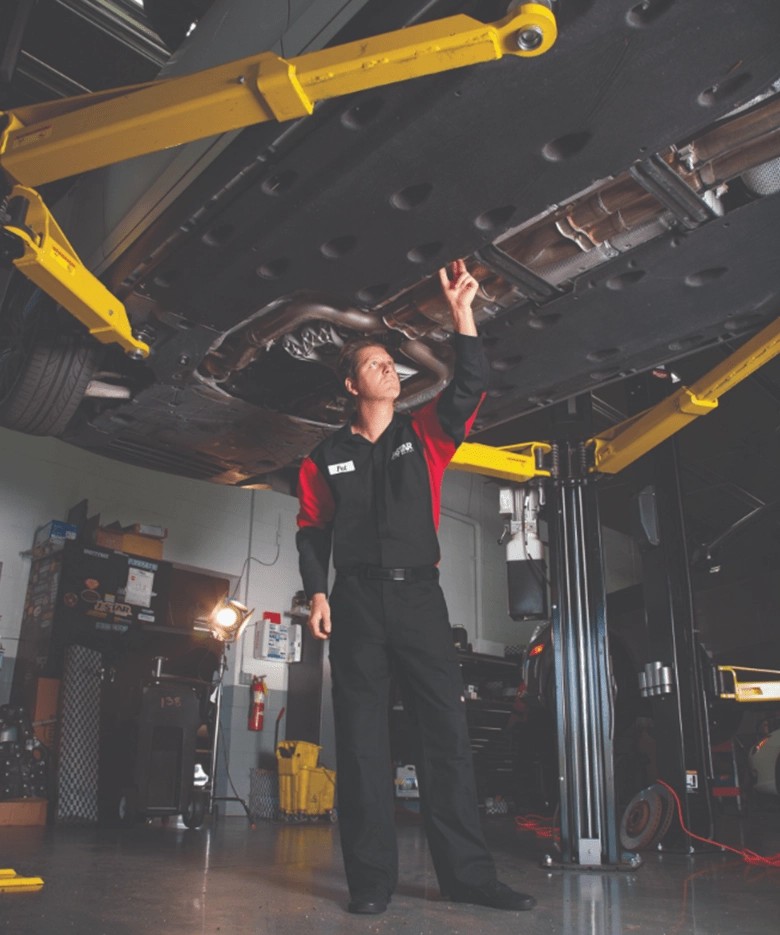Working in an auto repair shop can be a fulfilling career path, offering hands-on experience and the satisfaction of solving complex mechanical issues. However, the environment presents numerous safety hazards that, if not properly addressed, can lead to serious injuries. For both shop owners and employees, prioritizing safety is not just a matter of compliance—it’s about creating a secure and productive workspace for everyone. Implementing and consistently following safety precautions and rules is crucial for protecting yourself, your colleagues, customers, and the vehicles under repair. This article will outline essential safety tips and practices that every auto repair shop should adopt to ensure a safe working environment.
Essential Safety Tips for Auto Repair Shops
Creating a safe auto repair shop involves a multifaceted approach, from maintaining a clean workspace to adhering to strict safety protocols. Here are key safety tips that should be part of every auto workshop’s daily operations.
Establish Smoke-Free Zones
The presence of flammable and combustible materials is inherent in auto repair shops. Gasoline, oils, solvents, and even brake cleaner can ignite rapidly in the presence of an ignition source. Smoking in or near repair bays and garages poses a significant fire risk. Hot ash from cigarettes, cigars, or pipes can easily come into contact with these flammable fluids or vapors, leading to a potentially devastating fire. Designating and strictly enforcing smoke-free zones is a fundamental step in preventing accidental fires and protecting the entire shop.
Maintain a Clutter-Free Workspace
A cluttered workspace is not just inefficient; it’s a significant safety hazard. Tools scattered on the floor, hoses draped across walkways, and parts piled up in work areas create tripping hazards and impede movement, especially in emergencies. Keeping work areas clean and organized is paramount for maintaining a safe auto garage. This includes promptly picking up tools after use, utilizing tool cabinets and storage solutions to keep walkways clear, and ensuring parts and equipment are stored neatly. An organized workspace allows for quick access to tools and safety equipment, reduces the risk of accidents caused by tripping or falling, and improves overall efficiency.
Wear Proper Personal Protective Equipment (PPE)
Personal Protective Equipment (PPE) is the frontline defense against many common auto repair shop injuries. Depending on the task at hand, different types of PPE are necessary. Safety goggles or glasses are essential to protect eyes from flying debris, sparks, and chemical splashes. Gloves should be worn when handling chemicals, hot parts, or sharp objects to prevent skin irritation, burns, and cuts. Ear protection, such as earplugs or earmuffs, is crucial in noisy environments to prevent hearing damage. For tasks that generate dust or fumes, respirators or masks may be required to protect respiratory health. Ensuring that all employees have access to and consistently use appropriate PPE is a cornerstone of basic shop safety.
Mandate Proper Work Apparel
What employees wear in an auto repair shop is as important as other safety measures. Loose clothing, ripped or torn garments, and even jewelry can pose significant risks. Loose clothing can get caught in moving machinery, leading to serious injuries. Torn clothing offers less protection against chemicals and sharp objects. Establishing and enforcing dress code policies that prohibit loose clothing and mandate appropriate work apparel is essential. Many shops opt for customized uniforms and work apparel from reputable uniform service companies. These uniforms are designed for the demands of auto repair work, often made from durable, fire-resistant, and chemical-resistant materials, offering enhanced protection and promoting a professional appearance.
Fire Safety Measures – Maintain Fire Extinguishers
Fire extinguishers are indispensable auto safety products in any automotive shop. Given the fire hazards present, readily accessible and properly maintained fire extinguishers are critical. It’s not just about having extinguishers; it’s about having the right type of extinguisher for the specific type of fire risk. Class A extinguishers are for ordinary combustibles, Class B for flammable liquids, Class C for electrical fires, and Class D for combustible metals. Many shops utilize multi-purpose ABC extinguishers. Fire extinguishers should be strategically placed throughout the shop, clearly visible and easily accessible. Regular inspections to ensure they are charged and in good working order are vital. Furthermore, all employees should be trained on the proper use of fire extinguishers and the location of each within the shop. Having fire extinguishers is only effective if employees know how and when to use them.
Battery Safety
Vehicle batteries, even when a vehicle is turned off, can pose electrical hazards. When working on electrical systems or near electrical wiring, disconnecting the battery is a fundamental safety precaution. This eliminates the risk of accidental electrical shocks and prevents damage to sensitive electronic components. Always disconnect the negative terminal first and reconnect it last. Be cautious of battery acid, which is corrosive; wear gloves and eye protection when handling batteries. Proper disposal of old batteries is also crucial, as they contain hazardous materials.
Engine Safety
Engines are complex and powerful machines with numerous moving parts and high operating temperatures. Never place hands, tools, or any objects near a running engine. Moving belts, pulleys, fans, and other components can cause serious injuries if they come into contact with hands or clothing. Engines also generate significant heat, and components like exhaust manifolds and radiators can cause severe burns. Always allow engines to cool down before working on them, and use caution even when the engine is off as parts can remain hot for some time.
Vehicle Lifting and Support Safety
Working underneath vehicles is often necessary for repairs, but it’s also one of the most dangerous tasks in an auto repair shop. Never work under a vehicle that is only supported by a jack. Always use jack stands or a vehicle lift to properly and securely support the vehicle before going underneath. Inspect jack stands and lifts regularly for damage or wear. Ensure the vehicle is correctly positioned and stable on the supports before starting any work. This workshop safety rule is non-negotiable; neglecting it can lead to catastrophic injuries or fatalities if a vehicle falls.
Key and Electrical System Safety
Leaving the key in the ignition switch, even when the vehicle is off, can pose risks. The key can inadvertently draw an electrical charge, and accidentally turning the ignition on while working on the vehicle can be dangerous. Always remove the key from the ignition when performing repairs. Similarly, avoid unplugging fuses or wiring harnesses while the key is in the “on” position, as this can lead to electrical shocks or voltage spikes that can damage electronic components.
Temperature Awareness
Vehicles generate and retain a significant amount of heat, especially after running. Before commencing any work, be aware of the vehicle’s temperature. Engine components, exhaust systems, manifolds, and radiators can reach extremely high temperatures and cause severe burns upon contact. Radiator coolant is also under pressure when hot and can喷出scalding liquid if the system is opened prematurely. Allow sufficient cooling time before working on these components, and use caution and protective gloves when handling potentially hot parts.
No Food or Drink in Work Areas
Eating and drinking in the work areas of an auto repair shop is a risky practice. Workshops contain numerous chemicals, solvents, oils, and other contaminants that can easily transfer to food and drinks, leading to ingestion and potential health issues. Furthermore, eating or drinking while working on vehicles or parts is unprofessional and unhygienic, particularly if customers are present. Designated break rooms or kitchen areas should be established for eating and drinking, away from the contamination risks of the shop floor.
Understanding and Complying with Safety Regulations
Beyond general safety practices, auto repair shops must adhere to a range of safety laws and regulations at the federal, state, and local levels. Compliance is not only legally required but also essential for creating a genuinely safe and responsible working environment. Regularly educating and retraining employees on these regulations is vital.
Federal, State, and Local Regulations
Federal Regulations:
- The Clean Air Act (CAA): This act mandates that technicians who work on vehicle air conditioning systems handling refrigerants must obtain Section 609 certification from the EPA. This ensures proper handling and disposal of refrigerants to protect the environment.
- Resource Conservation and Recovery Act (RCRA): Auto shops are responsible for the cradle-to-grave management of hazardous wastes generated in their operations. This includes proper identification, storage, transportation, and disposal of materials like used oil, solvents, and batteries. Compliance with RCRA minimizes environmental contamination and health risks.
- Occupational Safety and Health Administration (OSHA): OSHA sets and enforces workplace safety standards to protect workers across various industries, including auto repair. OSHA regulations cover a wide range of safety aspects, from proper use of PPE and hazard communication to training requirements and emergency procedures. Following OSHA mechanic shop regulations is fundamental for maintaining a safe and compliant work environment.
State Regulations:
State regulations often mirror or expand upon federal guidelines. State environmental protection agencies typically have their own regulations regarding vehicle emissions testing and hazardous waste disposal, which auto repair shops must comply with. Additionally, the Department of Motor Vehicles (DMV) in each state may have specific requirements for licensing and registration of repair shops, ensuring they meet certain operational and safety standards.
Local Regulations:
Local regulations can add another layer of safety and environmental compliance. Local environmental ordinances may impose further restrictions on emissions, waste disposal, and water runoff to protect the immediate community. Compliance with local building and fire safety codes is also critical. These codes often dictate rules for the storage of flammable materials, the installation and maintenance of fire suppression systems, and building safety features. Adhering to these local regulations ensures that auto repair shops operate responsibly within their communities and minimize local risks.
The Role of Automotive Repair Safety Apparel
Protective clothing is a major component of staying safe in an auto repair shop. Beyond simply wearing uniforms, selecting the right type of mechanic safety equipment and apparel can significantly reduce the risk of injury. Consider these essential items:
- Gloves: Protecting hands is paramount. Mechanics frequently handle hot engines and parts, sharp objects, and corrosive chemicals. Durable work gloves, including specialized gloves for chemical resistance and heat protection, are essential to prevent burns, cuts, and skin irritation.
- Goggles: Eye protection is non-negotiable. The risk of eye injuries from flying debris, chemical splashes, and accidental impacts is high in auto repair environments. Safety goggles or glasses, designed to meet industry safety standards, provide critical protection against these hazards.
- Overalls: Overalls offer comprehensive body protection. Lightweight yet durable overalls, ideally made from materials like cotton or flame-resistant fabrics, are ideal for automotive workers’ uniforms. They shield the body from dirt, grease, hot liquids, and other debris, while still allowing for comfort and freedom of movement.
- Sturdy Shoes: Foot protection is often overlooked but incredibly important. Heavy tools and car parts are frequently handled and can be dropped. Sturdy work shoes or boots with steel toes or reinforced toe protection are crucial to prevent foot injuries from impacts and punctures.
Prioritizing safety in an auto repair shop is an ongoing commitment. By implementing these safety tips, adhering to regulations, and ensuring the consistent use of appropriate safety apparel and equipment, shop owners and employees can create a safer, healthier, and more productive work environment for everyone. Remember, a safe shop is not just a compliant shop; it’s a shop where people feel valued and protected, leading to better morale, reduced downtime, and a more successful business overall.


